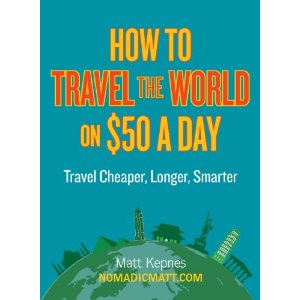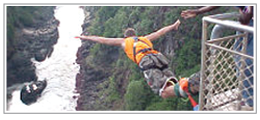This is the first book review I’ve ever done. Well actually it’s more of a discussion of a book written by my buddy, Matt Kepnes, better known as Nomadic Matt. I first met Matt in Las Vegas a few years ago after buying an e-book of his about making money with your blog. We have since become friends and now hang out a fair amount as he has recently moved to New York City. We were also recently on a trip to the Bahamas together where the oxygen masks came down on our plane-he’s the guy two rows behind me taking a picture of me taking a picture of myself!
Matt recently came out with a book called How to Travel the World on $50 a Day. Although my travel style now is different than Matt’s, I have to say it is pretty impressive-even though he misspelled my name in the acknowledgements section (Abamonte instead of Abbamonte). I enjoyed the book and can really relate to it.

I didn’t always travel in the fairly luxuriously manner I do now. My first 6-8 years of traveling from about 1998-2006, were done pretty bare bones. I was more concerned with seeing the places and experiencing them than where I stayed. I traveled with a backpack, often stayed in hostels and guesthouses, used discount cards and did many of the things Matt talks about in his book. Some I still do-I still have an ISIC card!
My favorite part of the book is how Matt breaks down costs and tips for saving money in certain areas of travel such as online banking or foreign bank accounts. I also love how he breaks down credit cards and points/miles as a way of really earning some free trips or other awards. I couldn’t agree more with many of his points about using credit cards to get free miles and trips and how opening credit cards doesn’t hurt your credit score.
I have an 800 credit score and have had several credit cards from various airlines at different times. The key to maintaining a good credit score is to not miss payments and avoid those stupid department store credit cards that can kill a score.
Matt also does a great job of talking about travel insurance and buying a backpack; which I think are two very important things for budget travel. I no longer carry a backpack but I use an Osprey bag that can be converted into a backpack if I wanted to. I find it more appealing for myself these days as I do more luxury and business travel. However, in my backpacking days I used an Arcteryx bag religiously and loved it.
As I mentioned, Matt speaks a lot about travel insurance and I agree you cannot be cheap about your health. I know a guy who had to get air lifted off Mount Kilimanjaro and it would have cost him some $30,000 if he hadn’t had trip insurance. I have never actually filed a claim myself, knock on wood, but I am covered as I write this on the Eurostar between London and Paris just in case from STA Travel. I have used their insurance for years. Matt recommends World Nomads; which is also very good I have heard.
Finally, Matt breaks the world down into backpacker friendly destinations and regions. He targets the world to where most backpackers go and gives great tips on how to save money and budget for the trip.

I agree with most of his points on many regions of the world and in fact, I couldn’t have said it better many times. However, I do disagree with him on a few points around Australia, Western Europe and in general. Australia used to be a cheap destination but now with the weakness of the US Dollar, it has become one of the more expensive destinations in the world. I don’t think it’s feasible to travel Australia, especially in a major city like Sydney or Perth on $50 a day. I suppose it’s possible but then you’d be sacrificing the experience to save a few dollars; which to me is the ultimate sin in travel.
The same goes for Europe where the price of the Euro has really hurt US tourist dollars. You can certainly travel Europe (in some places) on $50 a day but you’d have to do minimal sightseeing, tours, events, nightlife, etc. And by minimal I mean basically none after accommodation and cooking your own basic food. You need to save where you can obviously but not miss out on the reason why you are traveling in the first place!
For me personally, if I wasn’t able to eat the good local food, i.e. restaurants and street food, and experience the local nightlife, culture and sites, it wouldn’t even be worth it. You might as well just save longer/more and target a place you really want to experience as opposed to simply being there and challenging yourself to not spend money. That backpacking mindset has always been odd to me-travel longer by doing less.
That said, I think How to Travel the World on $50 a Day is a great reference for beginning budget travelers. It lays out how to plan for your trip, helps explain how to get over your fears and how to thrive on the road on a budget. This is good advice from someone who has traveled budget for years.












Impossible to travel the world on $50 a day these days as an American unless you do absolutely nothing whee you travel to or never leave southeast Asia sleeping in 16 person dorm room hostels!
Lee sort of missed the points on Australia and Europe – the concept of this book is a world average so in some places you spend more, some less. In Australia and Western Europe, I give a daily average higher than $50 but in other places, such as Southeast Asia, it’s much lower. In the end it all works out.
That being said there are plenty of ways to do the world on the cheap without sacrificing comfort. The problem in America is we assume travel is always a luxury resort experience but when you travel long term, you need to think differently. That being said you can find comfort on the cheap. I don’t like dorms, I eat $200 dollar sushi dinners, and I’m writing this from a suite in the Sheraton. The book’s all about how to travel on the cheap in comfort. A couple of tips off the bat:
1. Travel hack – use airline points, reward points, and travel credit cards to accumulate points for free travel. If you’re an American this is easy. This year so far I’ve accumulated 110,000 points using this method.
2. Eat at markets – Eating out isn’t always about eating a restaurant. Good local food can be food in tiny shops, local markets, street side cafes, food trucks, etc. Good food doesn’t mean expensive food.
3. Use public transportation – no brainer.
4. Avoid big hotel brands – There are tons of ways to find accommodation on the cheap. Airbnb, stay in locally owned guesthouses, camp, couchsurf, etc. Once you step out of the chains, prices drop a lot.
If you’re idea of a trip is 300 dollars meals, W hotels, and first class 100% of the time, this book isn’t for you. This book isn’t for luxury travelers. It’s for people who wan to go away on a vacation without spending a lot of money.
I agree with a lot of what Matt says here…he is right you can do everything cheap if you want to and not always sacrifice comfort etc. I think what’s throwing people is the $50 a day number because we can all agree that’s not possible everywhere but as Matt says if you average it…maybe…but the point is you can travel cheaply, longer and see a lot if you cut costs and are smart about using points etc
Sounds like wishful thinking but I will definitely check out the book.
Do have a look
That’s a book I need to get! I want to travel but don’t have any money! I don’t like hostels though 🙁
You can stay in guest houses and there’s also sites like couch surfing etc that can be used for free
I gotta get this book because I spend $50 walking out the door in LA and I can’t afford to go anywhere!
Haha I hear you on that! LA and NY don’t even count!
I have to agree with you Lee. Matt has some great tips on traveling and saving money. He has done his research and knows what he is talking about. However, the title is a little misleading as you can’t do $50 a day everywhere.
Agreed Jeremy but ya it’s the tips that are important on how to cut cost and save money
You sure can! It just depends on how you want to travel. I did Amsterdam on 30 Euros (close to 40 usd) a day once. by couchsurfing, cooking, and getting a train pass. Still had plenty for beers and museums too!
I don’t think it’s possible to travel on that type of budget anymore either but I do like the concept and thanks for bringing this up.
Sure thing buddy
I liked the objective review, Lee. My first trip was to Western Europe and sure, you can do it on $50 a day but I don’t see the point — I don’t want to eat hot dogs or cheap donairs all the time. Nor can I afford $300 on a hotel but I definitely think there can be a middle ground. It’s possible to splurge a bit, depending on what you value. I value great meals and good experiences so I’m willing to stay in a hostel but have a really nice meal for 30 euro that I enjoy. It doesn’t have to be one extreme or the other and it depends on the type of traveler you are. Matt knows how to stretch a dollar though and I’m happy he’s been able to share his tips in his book, which may be useful for those who want to backpack. Congrats Matt!
Agreed completely Natalie
Lee, I’m not sure how often you check your other posts, so figured I’d repeat this on your most recent, active thread. Funny, I found you from Matt’s blog, which I have “favorited”.
I am planning a trip to Southeast Asia later this year, probably starting in Oz and flying from Darwin to Dili. How did you get to Oecussi — I’ll probably head there and then on to Denpasar. Thanks for any info on traveling from Dili to Oecussi — did you take the overnight ferry or overland. Any hassle with Indo visas? Not too many people have posted about East Timor and very little info on Oecussi. Thanks much.
Hey Lee I found the info in the LP to East Timor so no need to reply. Not too much info as expected. Safe journeys round the globe.
ha ok, good luck…let me know how that goes for you…love to go back and see the changes since I was last there! Next time I’m in Bali-I’m gonna head back there.
I just did a 12month trip through 15 European countries, 2 in the middle east and 3 in Asia. I was conservative yet did everything I wanted to do and more. I spent an average of $50 per day and was enthralled by what I achieved. It is possible and as Matt says between the 3rd world and 1st world countries, in the end it all works out. For instance I lived off $5 a day in Mexico and it was one of the greatest 3 months of my life! Budget travelling may not be for everyone but it is possible to stick to it and be overjoyed with your travel experiences, Cheers for the book review/discussion